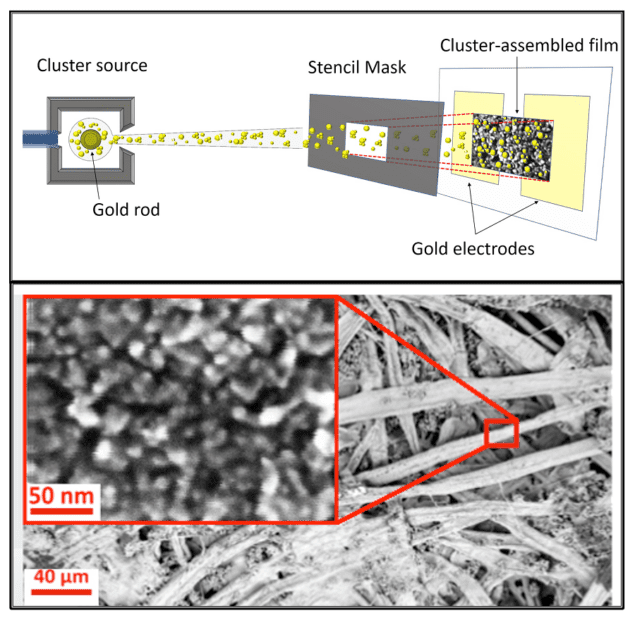
Whether it’s alternative technology for non-volatile memory or computing architectures that mimic the brain, when it comes to next-generation electronics the chances are a resistive switch is at the heart of it. Now for the first time researchers have fabricated a device that allows resistive switching with both the large ratio between resistance states needed for memory and the small ratio used in neuromorphic computing. In addition the device is printed on cheap and flexible plain paper, and can be mechanically reset by bending.
When a nanoscale morphology is characterized by “high porosity”, “roughness”, and “poorly connected and non-compact structures” a lot of people steer clear. However, as Paolo Milani explains, granular materials with a lot of defects at the nanoscale can have very interesting behaviour. He began to consider the possibility of resistive switching behaviour in the cluster-assembled materials he was investigating at Universita degli Studi di Milano in Italy when Simon Brown – who specializes in resistive switching research at the University of Canterbury in New Zealand – came to Milan on his sabbatical.
Milani and his colleagues in Milan were the first to demonstrate the potential of “supersonic cluster beam deposition” (SCBD) for bottom up nanofabrication. The technique involves vaporizing and sputtering a target material that then forms a supersonic beam, which passes through an expansion chamber and onto the substrate. They were also looking at paper as a cheap substrate for printing flexible devices, so the next step was to combine the two.
Brown and Milani worked with students Matteo Mirigliano and Chloé Minnai, who did many of the experiments and was a key part of the collaboration between the two groups. When they printed gold devices on glass and silicon using SCBD they were able to switch between low and high resistance states that were comparatively close to each other when they applied and removed a voltage. However when they printed the devices on paper they found a threshold voltage at which they could reversibly switch the device into a state with a resistance several orders of magnitude greater than the lower resistance states, revealing two resistive switching regimes in the same device.
“We did not suspect that paper could support resistive switching at all,” says Milani. Further surprises were in store when purely by accident the researchers discovered after bending the device, that it was reset to the low resistance state. Milani knows no other reports of a device that can accommodate two switching regimes or mechanical reset of a nanoscale switch.

Monolayer resets record for thinnest non-volatile memory device
Nanocoherer
Mechanical resistive switching reset is known at the macroscale, in the coherer devices Guglielmo Marconi exploited when he first developed the radio telegraph system in 1894. Those devices consisted of a glass ampoule containing metal filings that would switch from an insulating to a conductive state when a voltage was applied, and reset after tapping. While the device worked reliably enough to transmit Morse code messages and form the basis of the telegraph system for over a decade, the mechanism behind the switching and mechanical reset was never fully understood. Shedding light on the mechanism behind the resistive switching in the paper device could also provide insights into the operation of Marconi’s coherer.
“We suspect it is the fibrous structure of the paper that allows the two regimes,” he suggests. “There may be interplay between the nano and the microscale structures that gives rise to the dual regime, but we are investigating this.”
The results could also have implications for applications of nanoscale resistive switching devices, since the same device could be used for both memory and for mimicking the synaptic connections in neural systems that allow learning. “This could help if you start to build up more complicated neuromorphic architectures,” says Milani. Although this is just the first stage, both the functionality and the efficiency of computers could greatly improve by mimicking the brain, which effortlessly handles complex tasks all day on just three meals, a million times less than the power conventional computers consume for equivalent output.

Predictive disorder
Despite the apparent disorder in the deposited gold, the SCBD printing approach allows for a great deal of control over the level of disorder through careful selection of the deposition parameters, and this determines the initial resistance of the system. The threshold voltage at which the system switches between regimes in turn depends on this initial resistance. Although the disorder has discouraged some people from working with this kind of system, as Milani emphasises it is not random but disorder that can be very precisely controlled.
“We start to recognize nanogranular systems present physics that is very interesting – this has not been recognized,” he adds. “Before people wanted to embed these structures or put a shell around. But it’s the same as it was with macrosocopic granular matter, which is important, but it was only in the 1980s and 1990s that this was recognized as something that could be described with a solid theoretical approach.”
As well as printing artificial devices that share behaviour with neurons, the team have also successfully grown natural neurons with their technology, opening up interesting possibilities of designing systems that combine natural and artificial neurons. First however Milani is keen to understand the basic principle behind their resistive switching device and achieve better control for more complex devices.
Full details are reported in Nano Futures.



